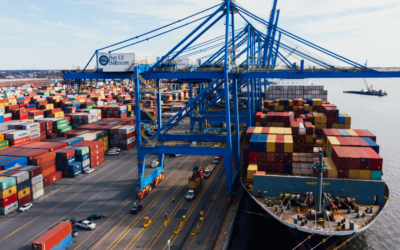Now that we’re midway through the third quarter of 2025, many businesses are assessing their current position and how they can continue a positive trajectory into Q4. The shipping business is no different. Transporters and freight forwarders are always looking at what is coming down the pike to ensure they are prepared. As we review current and upcoming disruptions in global shipping, we look to what’s new and how your business can stay one step ahead to ensure you’re always providing the best customer service.
Disruption #1: The Shifting Balance of Supply and Demand
Should companies maintain more stock in Q3 and Q4? Less? That’s a question that’s difficult to answer. While some industries are expanding, others are receding, making planning for the end of the year challenging. With wages growing faster than inflation, consumers have more money to spend. This surplus of income is a good thing for companies seeking opportunities to increase sales revenue.
Most supply chain forecasters are optimistic about sales, yet balance that with caution. If consumers continue to spend at their current rate, we may see a surge in inventory needs in the second half of 2025. This trend could have ripples across the supply chain and lead to disruptions in global shipping.
Planning Tip: Companies need to keep a close eye on sales and how much inventory they have, as well as how quickly or slowly it’s moving, so they can stay aligned with demand.
Disruption #2: Geopolitical Uncertainty
Several global issues continue to cause concern in the shipping industry. These include the war between Russia and Ukraine, hostilities in the Middle East and the Red Sea, cyberattacks as a weapon in international conflicts, and US-imposed tariffs. As an example of the direct effects of such geopolitical changes, in the last tariff increase in 2018, spot rates jumped 70% or higher on shipments between China and the US’s west coast. Tariffs may also be to blame for reduced trade. Global trade growth is predicted to slow to 1% from the same time last year as we enter Q4.
Planning Tip: Diversifying your supply chain can help alleviate challenges should wars, conflicts, and other difficulties arise. This will provide you with alternative supply sources to purchase goods.
Disruption #3: Hurricane Season
We’ve seen weather-related issues cause disruptions in global shipping previously. In 2025, we may be in for some serious challenges in this realm. Current predictions are calling for nearly 20 named hurricanes in the Atlantic Ocean during the season, which runs from June 1 through November 30. The first hurricane is expected in mid-August, and we’ve already seen four tropical storms, which are what lead to hurricanes. The reason for the increase is rising temperatures in the Atlantic, leading to marine heatwaves.
Of course, hurricanes aren’t the only weather-related challenge facing businesses in 2025. Record-breaking temperatures, floods, and droughts all contribute to shipping disruptions.
Planning Tip: Planning for increased or decreased needs based on weather will be key. It’s also important for businesses to work with carriers that can increase shipping in anticipation of severe weather.
Disruption #4: AI and Emerging Technologies
While most of us love the added convenience of leveraging ChatGPT in our everyday lives, there are pros and cons to any of the new technologies that are being rapidly adopted. While the integration of AI is predicted to lead to a 45% increase in on-time and error-free deliveries, it will take a bit of getting used to for companies, freight forwarders, and carriers alike. Additionally, AI tools sometimes come with a high price point and a steep learning curve.
Planning Tip: While companies may want to jump headfirst into an AI world, it may be smarter to proceed with caution. Partnering with a freight forwarder that is embracing AI may be a better way to take advantage of the technologies while avoiding assuming personal risk.
Disruption #5: Talent Gaps and a Changing Labor Market
It started with pandemic-related layoffs, transformed into the Great Resignation in 2021, and continues with uncertainties in today’s job market. No matter how you look at it, companies of all shapes and sizes are finding themselves facing challenges recruiting and keeping the right people in the right roles. This is affecting the supply chain, logistics, and operations, leading to current and future challenges for companies and shipping agencies.
Planning Tip: As a company that is heavily reliant on partnerships with freight forwarders, this issue shouldn’t affect your internal organization. However, staying in communication with your partner and being proactive with your needs will be key to success in this area.
Partner with a Freight Forwarder to Navigate Disruptions in Global Shipping
As we’ve stated again and again in this blog—and you can clearly witness with a look around or online—the world continues to shift and change. With it, the global economy and shipping also shift to accommodate our collective growing pains. As a company that relies heavily on consistency within your supply chain, your best bet is to trust a talented freight forwarder who can navigate whatever arises in the shipping industry.
With deep experience, clear communication, and a commitment to excellence, Cyclone Shipping stays in the know about any upcoming challenges and opportunities facing your business. You can trust us to help keep your shipments coming on time so you can focus on your customers. Contact us to learn more.




